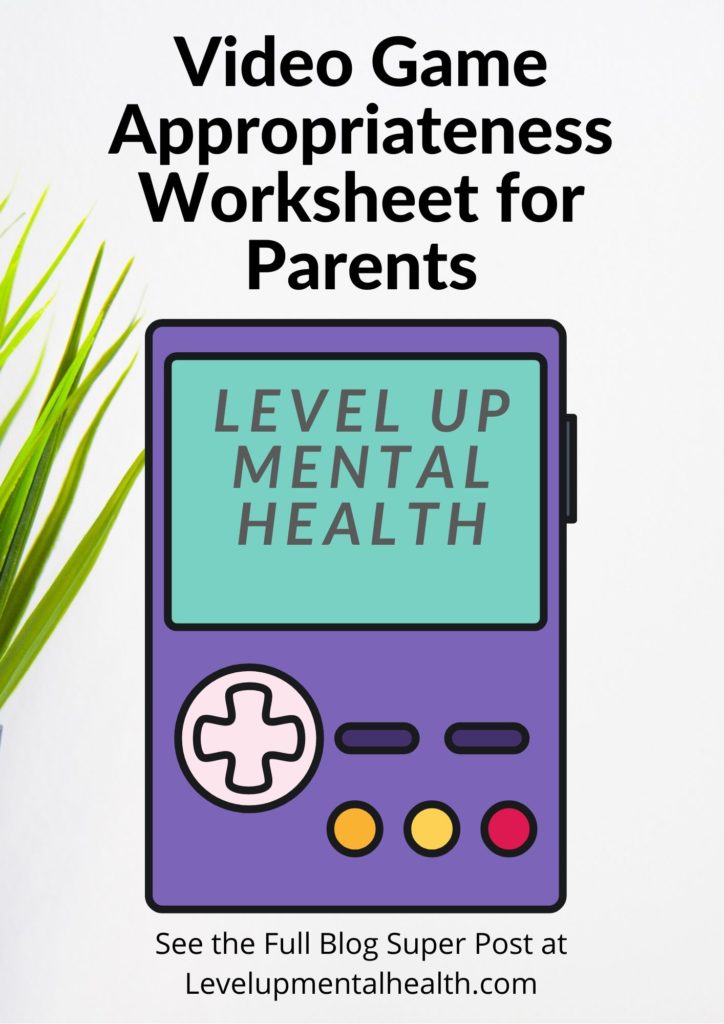Parents – do you have a child that loves video games? Have you ever felt overwhelmed by the sheer number of video games to choose from?
Read this guide to figure out how to pick the right game for your child?
When a parent is considering buying a video game for their child there are several competing interests at play. As a parent, your natural inclination is first and foremost to love, nurture, and protect your child. At the same time, your goals may also be fostering more independence and growth in your child and the most natural path towards those is through your child’s play. Over the past 30 years or so, video game play has become a staple to the average child’s list of fun activities. Learning always happens when you play video games but if you are interested in a method of keeping unhelpful or harmful learning to a minimum with your child’s video games you’ll want to read and bookmark this post.
Trust me – Bookmark it now. (Ctrl + D)
To make this work a bit faster you can download our free worksheet to accompany the guide if you subscribe to our 100% Free Newsletter. Click Here to sign up.
Background
A lot of media attention is focused on potential harms of video game play while little is given to the positive aspects of video game play. At the same time, the informed parent must understand that video game companies and advertisers design and promote details of a video game that make it desirable to purchase and to play — addictive in some circumstances. Therefore, when deciding if a game is worth purchasing for your child it makes the most sense weigh the pros and the cons of a particular game.
You should ask yourself “Will this game be harmful to my child and why?” while then asking “What value would this game bring to my child’s life?” But keep in mind, FUN cannot be ignored as an important factor in determining value. Make sure to read our post about the benefits of video game play. https://levelupmentalhealth.com/here-are-8-reasons-why-your-child-benefits-from-playing-video-games-in-moderation/
Choosing and understanding the world of Video Games can be a challenge for many parents
For the parent who plays video games, this mental tug-of-war may happen and resolve naturally. But for the parent who did not grow up playing video games or who has little personal interest in video games, this value conclusion may be much harder to arrive at. As a child psychiatrist, I have spent the last few years having discussions about the appropriateness of certain games. A game’s appropriateness for a child depends on several details about the game as well as the child who would want to play that game. Below we will primarily discuss aspects of the game that parents should pay attention to.
Also, it is worth noting that the way a child plays a game can alter this value to harm ratio. For example, a game could be perfectly harmless if you play it offline or with a friend/parent at your house, but switch it to online with voice chat on and you’ve got a whole new toxic ball game. Many young children and teens (including those that your child plays online with) may not have a full grasp on the fact that they are playing with a real person.
You can’t control who they randomly encounter online, but you must talk to them about your expectations of how they should behave online.
In this guide, we will talk about games specifically.
Instructions to use this guide
Feel free to skip around this list and come back and reference it when you are deciding on a game to purchase for your child. I will list a link for a checklist resource that you can print out and use. Before you do anything else, make sure you do the first TWO (2) steps – this may put a hard stop on a lot of the games that you would want your child to avoid.
Be sure to watch our video series on youtube – and Subscribe!
FIRST: Look at the title
You can tell a lot about a game from its title (BUT NOT ALWAYS). Games with titles such as “Mortal Kombat”, “Grand Theft Auto” or “Call of Duty: Modern Warfare” have clues to what games are about. We can see clues about the level of violence in the game. A game title can also state directly what the game is about. For example, “Madden Football” is a game about — if you accept that watching football is appropriate for your child, you will probably be fine with this type of game. Additionally, when you are at the store you should read the 5-6 sentence synopsis on the back to get a better idea of things (more in the Story/Theme section below).
Ask if there are any Red Flags from the title?
SECOND: Look at the ESRB rating
If you look at any video game box at the store or on your shelf, you will notice that there is a black letter in a white box. This is the ESRB rating (Electronic Software Rating Board) which I will link here. In short, this rating gives you an idea of the age group that the game is meant for: E = for everyone, E10 = is for 10 and older, T = for 13 and up, and M = for 17 and older. This is very similar to the ratings used in movie theaters. There are AO = Adults Only, but these games are not sold in stores (But they are sold online through services like STEAM). I would not recommend deviating from these guidelines by very much as they serve as a quick rule of thumb for parents. Pointing out the rating is a very useful tool to combat any complaints from your child. It’s right there in a Bold letter on the front cover, you can’t argue with that. If interested, you can flip the cover over and see a detailed breakdown of why the game was given that rating. For example, a game rated T may have things like Alcohol Reference, Blook, Fantasy Violence, Mild Language, Simulated Gambling, and Suggestive Themes.
The ESRB has done the lion’s share of the research for you, so I advise you to stick to their suggested age.

Violence Level
Many of today’s most popular games have some degree of violence. I would ask you to keep the context of the game in mind – if your child is playing a hero that is fighting bad guys (example: Lego Star Wars Series) that is a very different situation than if your child is playing a serial killer killing other players (example: Friday the 13th or Dead by Daylight). Now obviously you don’t want a very young child playing highly violent video games meant for adult video game players (you should note that the majority of video game players are adults and not children). However, if you restrict the game selection to the point of absolutely no violence, you would lose entire genres of video games. I will stress that you want to make sure that the level of violence is age-appropriate, maturity appropriate, and aligns with your household values (values that your child should know). Within each game genre, you will find variations of violence level, I will list some examples:
First/Third Person shooters
Low violence – Plants vs. Zombies: Garden Warfare
Medium – Fortnite (characters don’t “die” they are eliminated, but real looking guns are used)
High Violence – Call of Duty, Battlefield
Ultra-Violence – Gears of War
Open World Games
Low violence – Minecraft
Medium – Spider-man
High Violence – The Witcher 3 (parts can be ultra-violent)
Ultra-Violence – Grand Theft Auto V
Remember to always discuss the difference between fantasy video game violence and real-life violence with your child. As I write this in June 2020 I can (unfortunately) say that the level of violence your child is exposed to by watching the news or browsing social media far exceeds the violence level of a game rated T for teen or lower.
Sexual Content
Much like violent content, your margin for accepting sexual content in games that your child plays should take into consideration their age/developmental level, your household values, and your ability to have a serious discussion about material that may be in the game. Typically sexually suggestive material is not in games below the T for Teen rating, and nudity and graphic sexual scenes are reserved for M for Mature games (again parallel to an R rating in movies). The ESRB explanation on the back often has sexual content detailed.
Video games are considered a form of art and it is up to the artist or game developer in this case to decide on what is appropriate for their game. The game is then submitted to the ESRB and nudity/sexual content are a main factor that goes towards rating a game. However, I must reiterate that some of the games rated M for mature have somewhat graphic sex scenes. Games rate AO (Adults Only) can be pornographic in nature. (Update: The STEAM store does have a selection of this rating of video game and I would encourage you as a parent or caregiver to be the one in your household that makes the final purchase just in-case one of these games “accidentally” made its way into your child’s cart.)
Is the game without any sexual content? Does the game have crude sexual humor? Does it have sexually suggestive or adult themes? Does it have overt sexual intercourse or nudity shown in the game?
Addictive Factor

The word addiction is a very interesting word for video games. Many people seek out addictive games (sometimes by literally searching for “addictive games” on google). Many gamers equate addictiveness with fun. A better word might be “engagement” or “immersion” with a video game.
Modern games are designed to get the player to keep playing. This is a powerful mechanism that hooks both children and adults alike. As a parent, you must understand the power and draw of this and your child will benefit greatly from external reminders of their time limits.
As a parent, the level of addictiveness a video game carries can often determine how much conflict can come up when trying to get your child to move on to something else (like homework, sleep, or chores) or getting them engaged in offline activities (sports, scouts, piano, or dance as some examples). A game being immersive is not necessarily a bad thing and can be a strong tool for a parent to use to instill the values of time limits while also utilizing video games as a reward to promote better behavior (more on this below in the rewardability section).
Let’s talk about how games can be addictive in simple terms.
-Instant gratification – you press this button, then this happens, etc.
-A sense of progression
– leveling up, getting better, progressing through a story
-expected rewards in the game – non-random rewards (for example: leveling up)
-Unexpected rewards in the game – random rewards (finding a treasure or getting a powerful piece of loot to drop from an enemy)
-Fear of missing out by not playing or missing out on a day for daily rewards, daily activities, or daily challenges
-Peer pressure reinforcement – friends expecting you to play cooperatively with them
-Systems built into the game to encourage continued play (experience/point bonuses for continuing a win streak)
-Slot-machine like mechanics (sometimes there are actual slot machines in games) or loot boxes (banned in some countries). *Note that Loot boxes that contain rewards that give a player an advantage in winning are not allowed in full retail price games but loot boxes for cosmetic items (player costumes, weapon skins (alternative visual designs), or in-game pets are allowed.
-Seasonal content meant to entice the player to make additional purchases (For example Fortnite’s seasons content)
Social Environment Social Connectedness and social atmosphere of the game

Social connectedness is how enriching or not the game is as a social experience. Now depending on your child, you may want them to be more socially engaged (to learn social skills and make friends) and for others, you may want a situation where they are not playing with others and are free to play on their own (especially for younger aged children). A game’s social atmosphere can be thought of on a spectrum of socially welcoming and supportive and conversely a toxic or hostile environment (obviously the former is ideal to the latter). There is an inherent risk when you allow your child to play video games with strangers online – you must make your own decisions about keeping your child offline, restricting their use of communication tools like microphones, or giving them the full liberty to play with communication enabled.
Many children use video games to communicate with their friends. It may surprise you that a large portion of social learning happens over a video game platform. As your child grows and develops it may become necessary for parents to change or alter the rules around online communication based on a child’s developmental level and their interactions with peers. For example, a very young child may need to be told to avoid strangers online and be taught about potential dangers. Be sure to check out my resource about and things that your child should never say to strangers online. Another example for teenagers is helping them to understand to avoid engaging in cyberbullying behaviors which is not limited to overt bullying or teasing but also in-game bullying such as trolling (saying provocative or annoying statements to get someone else angry and engage them in an argument) and griefing (playing to purposely destroy someone else’s experience in-game). As a parent, you can be helpful to your child by teaching them about some of the social pitfalls that may occur on a video game platform and also by emotionally inoculating them by teaching them about some of the problematic behaviors that people may conduct themselves with while on online video games.
Ask these questions: For young children, can they be safe to play their game without someone verbally harassing them? See my video/resource about 10 things to never share with strangers online. [link]For teens, does the game seem to serve as a way for them to stay connected to existing friends? Are they able to play without getting into verbal arguments?
Check out my article about the positives of video game play for more on this.
Story, Themes, and Moral Value

Often games can have very accessible, enriching, and thought-provoking stories or plots. Video games are a relatively new media but can deliver stories that similarly provoke thought and introspection akin to how a good film or a literary work can. Modern video games often attempt to appeal to us similarly. Again, I recommend that you keep your child’s developmental level and maturity in mind when thinking about theme and story when selecting an appropriate game. The ESRB rating can provide us with information about the appropriateness of the theme in a video game. An engaging video game can be valuable in reinforcing moral and humanistic values in many cases, but at the same time, plenty of games are neutral or are of negative value in that regard (If you are reading this I’m sure you can think of a few).
Again, a game that inspires with its story is wonderful, but not always necessary in-game selection as a video game’s primary goal is to be fun.
Evaluate if the game will have a positive story, neutral or bad/harmful (based on your child’s developmental level). Are there themes in the game that your child is not ready for yet?
Skills gained through play

Many games promote some sort of skill acquisition. Every time a child picks up a new game they need some time to learn the control and mechanics of the game and after what seems like no time at all they have learned how to play an entirely new game through rapid trial and error. Some games directly educate/train a child in certain skills. For example, Minecraft allows children to practice spatial reasoning through its game mechanic of using cubes to construct anything you can pull from your imagination. Another example would be the Just Dance series which as you would guess teaches you how to dance. Many games can be thought of as skills in their own right, and most games coach the player to become better and better through trial and error.
I have had several patients with poor hand dexterity improve their hand-eye coordination through playing video games. Keeping real-life benefits in mind when selecting a game can be a useful exercise when choosing whether or not to make a game purchase for a child.
Are there skills that your child can pick up from playing the game? Is mastering a difficult game something that may instill a sense of accomplishment?
Parental Guidance

When selecting a game it’s important to keep in mind whether or not you will need to provide some Parental Guidance for your child. If there are complicated or controversial issues within the game and may not completely rule out the game for your child but it may require more talking points on your part. Always consider if there is going to be a teachable moment from some of the content within a video game. If you allow for space for your child to be more inquisitive this will allow your child to ask more questions when there is complicated subject material. If you can do this with video games, you may notice that your child comes to you with their offline questions more readily. Just like with movies there may be things that pop up within the game that your child may need further explanation and direction on your part. Certain references may go over their head and they may need you to help with adding context.
In certain cases, it may require that you as a parent set down a series of rules or guidelines around the child’s video game play. When making a video game selection you should also consider how easy it will be for you to enforce certain rules or boundaries for your child’s play. The most obvious ground rule would be a daily time limit, which I leave to each of you decide for yourself – If you want further guidance on this I will point to the AAP’s screen time recommendations which are in my opinion on the mores strict side of things.
Are you able to create and maintain clear rules and boundaries around the video game you are choosing? Can your child keep to a time limit?
Sometimes these challenges lead to the most significant growth.
Rewardability
Video games can be among one of the most rewarding activities for a child. As such it may be in a parent’s best interest to utilize that fact and use the video game as a reward or a goal for completing a certain behavior such as completing chores or finishing a child’s homework. The act of purchasing the video game in itself can be a long-term reward for a child completing behaviors over a period of time. Most children benefit from a mix of long term and short term rewards (younger children and less mature children may respond better to short term rewards).
Daily video game play may be a reward in the short-term. I always suggest that parents create a checklist of things that the child should complete before initiating their video game play for the day and you can also provide them with ways to earn further video game play if you’re so inclined. I always recommend that parents provide their child some way to earn more video game time played during school breaks as long as it won’t interfere with them going to school or getting their adequate rest. Parents often mentioned to me that they don’t want to feel like they’re driving their children or making them materialistic but then I asked them “Would you go to work for free?” and most would say “No.”
Can you use this game as a reward?
Ease of taking breaks

When selecting video games you must also keep in mind how easy or difficult it will be for your child to stop the game play for the day or to take a break. Factors to consider include is the game pausable, how long does it take to have a good gaming session (15 minutes, 30 minutes, an hour, 6 hours?), can the child log in and then log back out without ruining their gaming session, is your child prone to tantruming when you ask them to stop the game?
It’s important to know that there are games such as Fortnite that cannot be paused and if your child starts playing this type of game it is probably their expectation that they’ll be able to complete the round/game without disturbance. Issues with this kind of game come up often in my office and the child may complain “My Mom/Dad doesn’t respect me or my time, I was only a few minutes away from winning and they pulled my power cable.” So for non-pausable games, I recommend coming to a mutual agreement about the length of playtime and having a discussion with your child about exceptions to their uninterrupted time (such as they didn’t complete their homework, emergencies, it is eating into dinner time). Engage your child in this discussion before you purchase or allow them to play the game (Fortnite is a Free game).
If your child has problems with complying with this for online games I would recommend the use of an actual timer or giving verbal time warnings (which you can expect most will try to negotiate). Pick your battles – you may find it less daunting to tell them “Okay finish up that match” rather than “Turn that off right now!”Can your child walk away from the game or pause it? If not, can you and your child come to an agreement about uninterrupted play and exceptions to that?
Hidden costs

In the past most video games used to carry a sticker price that you would pay one time and then you had the full game experience. Over the past decade or so for video game companies to make higher profit margins and capitalize on their established customer base (your child who already bought the game) companies have begun creating downloadable content add-ons for their games and/or making in-game or in-app purchases or content (often allowing a person to trade money for saved time in-game). The worst example of this would be loot boxes and you should know that currently, many countries are attempting to have this practice banned within video games.
The worst culprit of in-app purchases tends to be free-to-play mobile games which will often have slot machine-like loot box prize pulls. Usually, there is a $1 option up to a $100 option which gives you bonuses. You may now start to understand why companies would be interested in creating games with this pay structure. Some people might only pay a few dollars here and there, but some may pay hundreds if not multiple thousands of dollars on digital add-ons.
On that note, watch out for games with premium currency. Premium currency is in-game money that you have to buy with real money. Some games give people a chance to earn a small amount of premium currency, but the time to earn anything of value would take so long that having such an option is there to coerce the player into spending real money. If you wish to purchase such a thing, please take some time to set very rigid limits on the practice.
In my opinion, children should never have access to make in-app purchases for random rewards in mobile games as there is some evidence that later on in life a person becomes more susceptible to problematic gambling. This is done through the reward pathway in the brain and is driven by Dopamine – a chemical in the brain that signals pleasure but can also drive true addiction. Also, by allowing for this once you’re opening up a Pandora’s Box and you can be sure that your child will continue to ask for you to repeat this Behavior. So again I’ll reiterate don’t let your child get in the habit of buying random in-app purchases. Ask yourself if the game has add-on content. Is it expansion or season pass content that has a known dollar value, or does it have a limitless amount of content that can be purchased?
Child’s personal traits
When making a selection for a video game you must consider who it is that will be playing them. Who is your child, what kind of person is he or she? Hopefully, you are the best person to know about who your child is as a person. You are the expert and probably know their tendencies better than anyone.
There are a few things that you should ask yourself. Does your child have a tendency towards having a temper? Is your child or teenager prone to hostile behavior online or having online arguments? What is the maturity level of your child? Does it match the game that they are choosing? Every household has its own goals, values, comfort level – make sure that the game aligns with those.
Will this game bring value?
The final question you should ask yourself is will this game bring value to your child’s life? If you have gone through this list and evaluated each step you should have a pretty good idea of whether or not a game will bring value to your child’s life. Keep in mind that fun absolutely counts within this value determination. If it isn’t a fun game your child probably doesn’t want it and you should move on to a better game or one that aligns with your child.Video games are just forms of entertainment at the end of the day and that is their main goal. Hopefully, this list will help you to ask the right questions about the value of a video game in a fairly systematic way while keeping them safe and keeping you comfortable with your decision to purchase the game.
Other Quick Tips
Here are a few things that you can do to help you figure out the information above:
-Sign up for the newsletter here on levelupmentalhealth.com and work through the free worksheet for Newsletter subscribers.–
Watch the game’s trailer on YouTube
-Check Commonsense.org
-Check game’s Wikipedia page
-Watch a gameplay video for a few minutes on YouTube
-play the game yourself if you can rent it or borrow it
-If it is a free game then you can download and play it yourself first
Make sure to sign up for our newsletter as we are also giving you access to our worksheet that gives you a quick way to run through this information. Be sure to bookmark this post so that you can refer to it each time you want to pick a new game for your child.
Click Image below.
Don’t forget to Subscribe to our Youtube Channel. This post will have an accompanying Video Playlist Soon (late summer 2020).


0 Comments